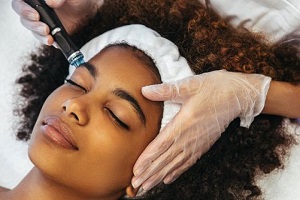Dermabrasion is a cosmetic procedure used to improve the texture and appearance of the skin. It involves the controlled removal of the outermost layers of skin using a rotating instrument with abrasive surfaces. This procedure helps to smooth out irregularities, reduce the appearance of scars or wrinkles, and improve the overall tone and texture of the skin. Dermabrasion can be performed on various areas of the body, including the face, neck, hands, and other areas with skin concerns.
Here is a general overview of the dermabrasion procedure:
- Consultation: Before undergoing dermabrasion, you will have a consultation with a dermatologist or a qualified skincare professional. They will assess your skin condition, discuss your expectations, and determine if dermabrasion is the right treatment for you.
- Preparation: On the day of the procedure, the treatment area will be thoroughly cleaned, and a local anesthetic or numbing cream may be applied to minimize any discomfort.
- Dermabrasion Procedure: The dermatologist will use a handheld device with a rotating abrasive instrument, such as a wire brush or diamond wheel, to gently remove the outer layers of the skin. The depth of treatment depends on the skin concern being addressed.
- Post-treatment Care: After the procedure, the treated area may be red, swollen, and sensitive. Your dermatologist will provide specific instructions on how to care for the treated area, including applying protective ointments and avoiding sun exposure. It is essential to follow these instructions to promote proper healing and minimize the risk of complications.
- Recovery: The recovery time varies depending on the depth and extent of the treatment. The skin will typically go through a healing process, during which new, healthier skin will replace the treated layers. It is common to experience some temporary redness, flaking, and sensitivity during this period.
It’s important to note that dermabrasion may not be suitable for everyone, and it may have certain risks and side effects. Possible complications include infection, scarring, changes in skin pigmentation, and prolonged redness. It’s crucial to consult with a qualified dermatologist or skincare professional to determine if dermabrasion is appropriate for your specific concerns and to discuss any potential risks or alternatives.

